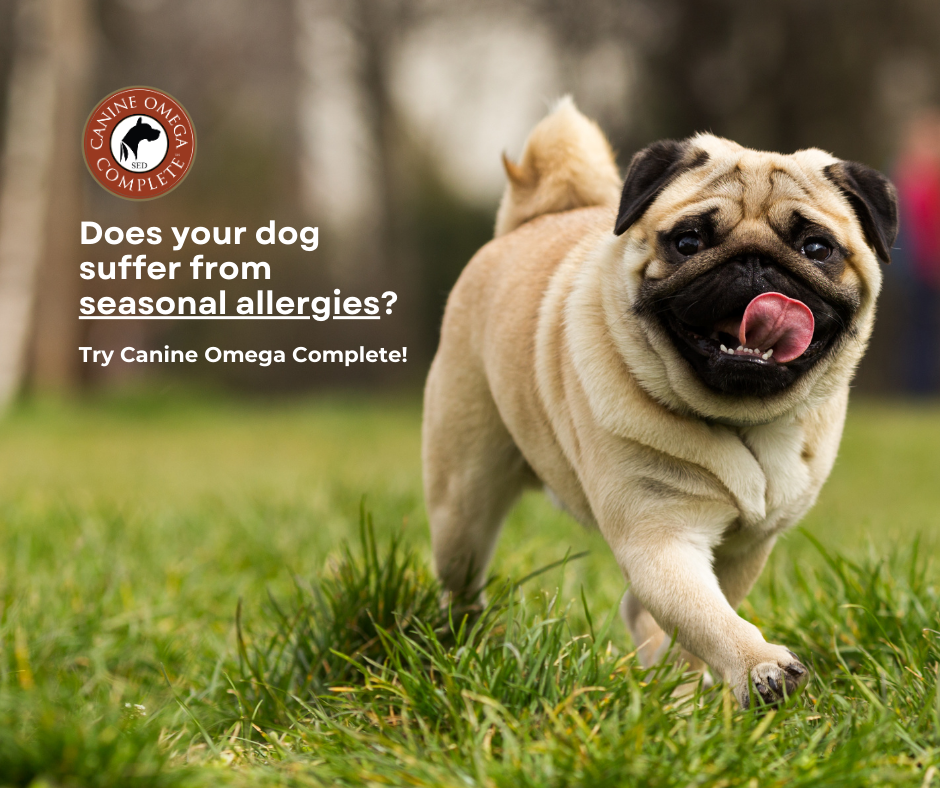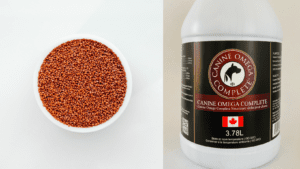Canine allergies can be a source of discomfort and frustration for both dogs and their owners. From food sensitivities to environmental triggers, allergies can manifest in various ways, including excessive shedding and itching. In this article, we will explore the causes of allergies in dogs, discuss the common symptoms to look out for and highlight the importance of proper treatment, including the role of Canine Omega Complete.
Causes of Allergic Reactions in Dogs
Various factors, including environmental allergens, food ingredients, and contact irritants, can trigger canine allergies.
Environmental Allergens
Dogs can be highly sensitive to various environmental allergens that are commonly found in their surroundings. These allergens include pollen, dust mites, mould spores, and certain grasses or trees. Each of these allergens contains specific substances that can trigger allergic reactions in dogs, leading to discomfort and health issues.
Pollen, for instance, is a fine powder released by plants during their reproductive cycle. It can be carried through the air and easily inhaled by dogs. Pollen from various plants, such as trees, grasses, and flowers, can cause allergic reactions in sensitive individuals. The specific proteins present in pollen can stimulate the dog’s immune system, leading to an allergic response.
Dust mites are microscopic creatures that thrive in warm and humid environments. They feed on organic matter, including dead skin cells. Dust mite allergens are actually the proteins found in their bodies and waste products. When dogs come into contact with dust mites or their allergens, either through direct contact or inhalation, they can develop allergic symptoms.
Mould spores are tiny reproductive structures produced by various types of fungi. They can be found in damp areas both indoors and outdoors. When dogs inhale or come into contact with mould spores, their immune system can react to the proteins present in these spores, triggering an allergic response. Some dogs may be more sensitive to specific types of mould, such as Aspergillus or Penicillium, while others may be more reactive to a broader range of mould species.
Certain grasses and trees also produce allergenic substances that can affect dogs. For example, Bermuda grass, ragweed, and oak trees are known to produce pollen that can cause allergic reactions in dogs. The proteins present in the pollen of these plants can lead to itching, redness, and other allergic symptoms when dogs are exposed to them.
Contact Allergies
Dogs can also develop allergies from direct contact with certain substances present in their environment. These substances can include cleaning products, chemicals, or plants. Dogs have sensitive skin, and contact with allergens can lead to skin irritations or allergic dermatitis, characterized by redness, itching, and inflammation.
Cleaning products and household chemicals often contain ingredients that can be irritating or allergenic to dogs. Harsh detergents, fragrances, or certain disinfectants may trigger allergic reactions when dogs come into contact with them. It’s important to be cautious when using such products around dogs and to opt for pet-friendly alternatives whenever possible.
Certain plants can also cause allergic reactions in dogs upon direct contact. For example, some dogs may be sensitive to the oils or sap present in certain plants, such as poison ivy, poison oak, or poison sumac. Contact with these plants can result in allergic contact dermatitis, characterized by redness, itching, and sometimes blistering or rashes.

Symptoms of Canine Allergies
Itching and Scratching
Dogs with allergies often experience intense itching, medically known as pruritus. Itching is a common and distressing symptom that can significantly impact a dog’s quality of life. Allergic itching is typically caused by the release of histamines and other inflammatory mediators in response to an allergen exposure.
During an allergic reaction, the immune system releases histamines, which bind to specific receptors on cells and initiate an inflammatory response. This inflammatory response causes itching sensations in the skin, leading dogs to scratch, bite, or chew on themselves in an attempt to alleviate the discomfort.
The scratching provides temporary relief from the itching, as it stimulates the release of endorphins that act as natural painkillers and offer momentary comfort. However, scratching also further irritates the skin, leading to increased inflammation and damage to the skin’s protective barrier.
As the skin becomes more inflamed and damaged, it becomes even more sensitive and prone to additional allergic reactions. This heightened sensitivity makes the dog more susceptible to future allergen exposures, exacerbating the itching and triggering a vicious cycle of itching and scratching.
With each cycle, the dog’s scratching intensifies, causing more damage to the skin. The persistent scratching can result in open wounds, sores, and the formation of hotspots, which are moist, red, and often painful areas of inflamed skin. These hotspots provide a favorable environment for bacteria and other microorganisms to multiply, increasing the risk of secondary infections.
The continuous scratching and skin damage also lead to a breakdown in the skin’s protective barrier, making it easier for allergens and irritants to penetrate the skin and trigger further allergic reactions. This perpetuates the cycle of itching, inflammation, and skin damage, creating a challenging situation for both the dog and their owner.
In addition to hotspots, the continuous scratching and biting can result in the development of other skin lesions, such as abrasions, sores, or scabs. The constant irritation and inflammation can further compromise the skin’s integrity, making it more susceptible to bacterial or fungal infections.
Moreover, excessive scratching and self-trauma can also disrupt the hair follicles, leading to hair loss and thinning of the coat. This can be especially concerning for dogs with long or dense fur, as hair loss can expose the skin to further damage, increasing the risk of secondary infections.
It’s important to note that itching and its consequences may vary in severity depending on the individual dog and the specific allergen involved. Some dogs may exhibit mild itching and minimal skin damage, while others may experience intense and persistent itching, leading to severe skin lesions and complications.

Take this quick quiz to identify the type, location, and severity of the potential reaction.
Skin Irritation
Allergies in dogs can manifest as various skin irritations, leading to discomfort and visible changes in the skin’s appearance. It’s important for dog owners to recognize the signs and symptoms of these allergic skin reactions to provide timely care and relief for their furry friends.
One of the common skin irritations caused by allergies is a rash. Dogs with allergies may develop red, inflamed patches of skin that can be itchy and uncomfortable. These rashes may appear localized in specific areas or can be more widespread, depending on the severity and extent of the allergic reaction. Rashes can occur in various parts of the body, such as the belly, groin, armpits, paws, or around the face and ears.
Hives, also known as urticaria, can also occur as a result of allergic reactions in dogs. Hives are raised, swollen areas of the skin that may be red or pale in color. They can range in size from small bumps to larger patches and can appear and disappear relatively quickly. Hives often cause intense itching and may be accompanied by other symptoms, such as facial swelling or difficulty breathing, in more severe cases.
Allergic dermatitis is another common skin condition that can result from allergies in dogs. It refers to the inflammation of the skin caused by an allergic reaction. Dogs with allergic dermatitis may experience redness, swelling, and small bumps or blisters on the affected areas of the skin. The skin may feel warm to the touch and can be quite itchy, leading dogs to scratch or bite at the affected areas, further exacerbating the irritation.
The specific areas of the body that are affected by these skin irritations can vary depending on the allergen and the dog’s individual sensitivity. Some dogs may primarily experience rashes or hives on their belly or paws, while others may develop facial dermatitis or have generalized itching and inflammation.
Ear Infections
Dogs with allergies are often prone to recurrent ear infections, and it’s important for dog owners to be aware of the potential signs and symptoms. Allergies can trigger an inflammatory response in the ears, leading to discomfort and an increased risk of infection.
One of the most common signs of an ear infection in dogs with allergies is excessive scratching of the ears. Dogs may use their paws or rub their heads against furniture or the ground in an attempt to relieve the itching and discomfort caused by the allergy. The scratching can further irritate the ears and make them more susceptible to infections.
Head shaking is another telltale sign of ear infections in allergic dogs. The dog may vigorously shake their head from side to side in an effort to alleviate the irritation and itchiness. This behavior can sometimes be quite forceful and may be accompanied by a distinctive “flapping” sound as the ears move.
Discharge from the ears is another common symptom. The discharge can vary in consistency and color, ranging from a watery or waxy discharge to a thick, pus-like substance. In some cases, the discharge may have a foul odor, indicating the presence of bacteria or yeast.
Redness and inflammation in the ear canal are also frequently observed in dogs with allergies and ear infections. The skin inside the ear may appear reddened, swollen, and irritated. The dog may exhibit signs of discomfort when the ears are touched or manipulated.
It’s important to note that these symptoms can also be indicative of other ear conditions, such as ear mites or foreign objects lodged in the ear. Therefore, it’s crucial to consult a veterinarian for a proper diagnosis and appropriate treatment.
Gastrointestinal Upset
Food allergies in dogs can trigger gastrointestinal upset, resulting in various symptoms that affect the digestive system. When a dog consumes food they are allergic to, it can lead to adverse reactions in the gastrointestinal tract. Common symptoms include vomiting, diarrhea, and excessive gas. The dog may experience frequent bouts of vomiting, which the presence of undigested food or bile can accompany. Diarrhea may be watery or soft, and the dog may have more frequent bowel movements. Additionally, some dogs may lose their appetite, leading to decreased food intake and subsequent weight loss.
Respiratory Problems
When exposed to allergens, dogs may experience respiratory symptoms similar to those seen in humans with allergies. This can include frequent sneezing, coughing, wheezing, or difficulty breathing. Some dogs may develop nasal congestion or discharge from the nose. In severe cases, allergic reactions can lead to respiratory distress, which requires immediate veterinary attention.
Treatment of Canine Allergies
The treatment of canine allergies aims to alleviate symptoms, reduce inflammation, and improve the dog’s overall well-being. Here are some common treatment approaches:
Allergen Avoidance
If the specific allergen can be identified, the first step is to minimize or eliminate the dog’s exposure to it. This may involve dietary changes, such as switching to hypoallergenic or limited ingredient diets or modifying the dog’s environment to reduce exposure to environmental allergens.
Medications
Veterinarians may prescribe medications to manage the symptoms of allergies. These can include antihistamines to reduce itching, corticosteroids to control inflammation, or topical treatments to soothe skin irritations.
Dietary Supplements
Omega fatty acids can play a role in managing canine allergies. Omega-3 fatty acids have anti-inflammatory properties that can help reduce itching and inflammation associated with allergies. Additionally, they can help support healthy skin and coat, reducing the risk of dryness and irritation.
Adding an antioxidant like vitamin E can help protect cells from damage caused by free radicals. It supports the skin’s overall health and helps maintain its integrity, supporting skin health and minimizing the risk of allergies.
Canine Omega Complete
Compared to traditional treatment options for canine allergies, Canine Omega Complete offers several advantages. Firstly, it provides a natural and holistic approach to managing allergies, focusing on the underlying immune response and inflammation. It does not rely solely on medications that may come with potential side effects. Additionally, Canine Omega Complete is easy to administer, as it can be added to the dog’s regular food once a day. There is no strict dosing schedule or monitoring required, making it convenient for pet owners.
Furthermore, Canine Omega Complete offers long-term usage benefits. Regular supplementation with omega fatty acids and vitamin E helps maintain healthy skin and coat, reducing the risk of allergies and providing ongoing support for the dog’s overall well-being. This makes it a valuable addition to the daily routine of dogs prone to allergies or experiencing allergic symptoms.
Conclusion
In conclusion, canine allergies can cause discomfort and distress for dogs, but with proper management and treatment, relief is possible. Identifying the underlying causes, recognizing the symptoms, and implementing appropriate treatment strategies are essential steps in helping dogs with allergies. Canine Omega Complete, with its blend of omega fatty acids and vitamin E, offers a natural and effective option for managing canine allergies. By incorporating this high-quality supplement into a dog’s diet, pet owners can provide the necessary support to promote a healthy immune response, reduce inflammation, and improve the overall well-being of their furry companions. Always consult a veterinarian for a proper diagnosis and guidance on the best treatment approach for your dog’s condition.






